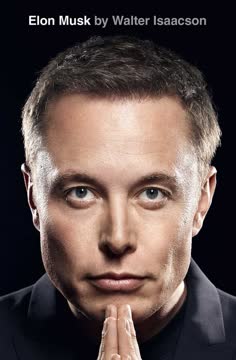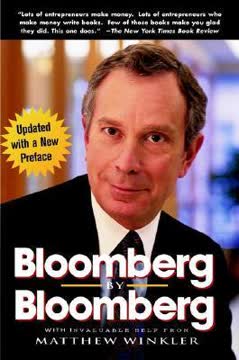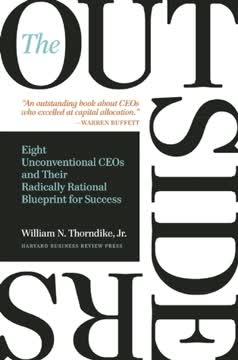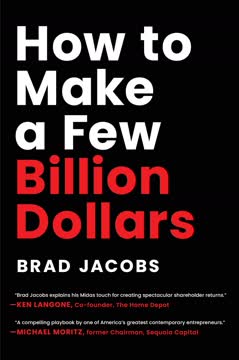Key Takeaways
1. Embrace frugality and value every dollar
"I have always been driven to buck the system, to innovate, to take things beyond where they've been."
Frugality as a core value. Sam Walton's upbringing during the Great Depression instilled in him a deep appreciation for the value of money. This mindset became a cornerstone of Wal-Mart's success, influencing everything from operational decisions to corporate culture.
Practical application of frugality:
- Minimizing overhead costs
- Negotiating aggressively with suppliers
- Reinvesting profits into the business
- Encouraging cost-saving innovations from employees
By consistently prioritizing frugality, Wal-Mart was able to offer lower prices to customers while maintaining profitability, fueling its rapid growth and market dominance.
2. Focus on customer service and satisfaction
"There is only one boss—the customer. And he can fire everybody in the company from the chairman on down, simply by spending his money somewhere else."
Customer-centric approach. Walton believed that serving the customer was the primary mission of any retail business. This philosophy drove Wal-Mart to continuously improve its offerings and operations to better meet customer needs.
Key aspects of Wal-Mart's customer focus:
- Everyday low prices
- Wide product selection
- Convenient store locations
- Friendly and helpful staff
- Satisfaction guarantee
By prioritizing customer satisfaction, Wal-Mart built a loyal customer base and established itself as a trusted retailer in communities across America.
3. Learn from competitors and adapt continuously
"I learned early on that one of the secrets to campus leadership was the simplest thing of all: speak to people coming down the sidewalk before they speak to you."
Competitive intelligence. Walton was relentless in studying competitors, visiting their stores, and adapting successful strategies to Wal-Mart's operations. This approach allowed the company to stay ahead of industry trends and continuously improve its business model.
Methods for learning from competitors:
- Regular store visits to observe operations and merchandising
- Analyzing competitor pricing and product selection
- Adopting and improving upon successful strategies
- Encouraging employees to share insights from competitor stores
By fostering a culture of continuous learning and adaptation, Wal-Mart was able to outmaneuver competitors and maintain its market leadership.
4. Build a strong company culture and empower employees
"Outstanding leaders go out of their way to boost the self-esteem of their personnel. If people believe in themselves, it's amazing what they can accomplish."
Culture of empowerment. Walton recognized that engaged and motivated employees were crucial to Wal-Mart's success. He developed a unique corporate culture that emphasized teamwork, shared success, and individual empowerment.
Key elements of Wal-Mart's culture:
- Profit-sharing programs
- Open-door policy for communication
- Promoting from within
- Encouraging entrepreneurial thinking at all levels
- Recognizing and rewarding employee contributions
By creating a strong sense of ownership and pride among employees, Wal-Mart fostered a dedicated workforce that consistently delivered exceptional results.
5. Invest in technology and efficient distribution systems
"I was never satisfied with the way we handled our distribution system, and I still isn't."
Technological innovation. Walton recognized early on that investing in technology and efficient distribution systems would be crucial to Wal-Mart's growth and profitability. This foresight allowed the company to scale rapidly while maintaining operational efficiency.
Key technological investments:
- Computerized inventory management systems
- Satellite communication network
- Automated distribution centers
- Bar code scanning and point-of-sale systems
- Data analytics for demand forecasting
By leveraging technology to streamline operations and reduce costs, Wal-Mart was able to offer lower prices to customers while maintaining healthy profit margins.
6. Expand strategically and maintain local market focus
"We got into the discount business when nobody really wanted us, and the only way we could get into business was to go to these small towns."
Strategic expansion. Walton's approach to growth was methodical and focused on saturating local markets before expanding to new regions. This strategy allowed Wal-Mart to build strong brand recognition and economies of scale in each area it entered.
Key aspects of Wal-Mart's expansion strategy:
- Starting in small, underserved markets
- Gradually expanding outward from existing strongholds
- Adapting store formats to local needs
- Building distribution centers to support regional growth
- Acquiring smaller chains to enter new markets
By maintaining a local focus while expanding nationally, Wal-Mart was able to build a vast network of stores while retaining the feel of a hometown retailer.
7. Foster open communication and share information
"The key to success is to get out into the store and listen to what the associates have to say."
Transparency and information sharing. Walton believed in the power of open communication and information sharing to drive better decision-making and foster a sense of ownership among employees.
Practices that promote open communication:
- Weekly Saturday morning meetings
- Sharing financial information with employees
- Encouraging feedback from all levels of the organization
- Regular store visits by executives
- Open-door policy for all employees
By creating a culture of transparency and open dialogue, Wal-Mart was able to tap into the collective wisdom of its workforce and respond quickly to changing market conditions.
8. Cultivate a bias for action and embrace change
"Capital isn't scarce; vision is."
Action-oriented mindset. Walton believed in the importance of taking decisive action and being willing to experiment with new ideas. This approach allowed Wal-Mart to stay ahead of industry trends and continuously improve its operations.
Ways Wal-Mart cultivated a bias for action:
- Encouraging experimentation at the store level
- Quickly implementing successful ideas across the chain
- Empowering employees to make decisions
- Embracing failure as a learning opportunity
- Constantly seeking ways to improve and innovate
By fostering a culture that valued action and embraced change, Wal-Mart was able to adapt quickly to evolving market conditions and customer needs.
9. Give back to the community and practice ethical business
"If you want a successful business, your people must feel that you are working for them—not that they are working for you."
Community engagement. Walton believed that Wal-Mart had a responsibility to give back to the communities it served. This commitment to social responsibility helped build goodwill and strengthen the company's reputation.
Ways Wal-Mart practiced corporate citizenship:
- Supporting local charities and community organizations
- Encouraging employee volunteerism
- Providing disaster relief in times of crisis
- Implementing environmentally sustainable practices
- Creating job opportunities in local communities
By prioritizing ethical business practices and community engagement, Wal-Mart was able to build strong relationships with customers and stakeholders, contributing to its long-term success.
Last updated:
FAQ
What's Sam Walton: Made In America about?
- Personal Journey: The book is an autobiography of Sam Walton, detailing his rise from a small-town store owner to the founder of Wal-Mart, the largest retailer in the world.
- Business Philosophy: Walton shares his business strategies, focusing on customer service, low prices, and treating employees as partners.
- Cultural Impact: It explores how Wal-Mart transformed retailing in America, especially in small towns, and the challenges faced during its expansion.
Why should I read Sam Walton: Made In America?
- Entrepreneurial Inspiration: The book is a motivational guide for aspiring entrepreneurs, showcasing Walton's innovative thinking and relentless drive.
- Leadership Lessons: Readers can learn about leadership, teamwork, and the importance of a strong company culture that values employees and customers.
- Retail Insights: It provides a deep understanding of the retail industry and the strategies that made Wal-Mart a dominant force.
What are the key takeaways of Sam Walton: Made In America?
- Hard Work and Dedication: Walton emphasizes the importance of hard work, stating that it was crucial for his success.
- Customer-Centric Philosophy: The book highlights the importance of prioritizing customer needs and providing value.
- Employee Partnership: Walton discusses the significance of treating employees as partners, which leads to better performance and loyalty.
What are the best quotes from Sam Walton: Made In America and what do they mean?
- "We just got after it and stayed after it.": Reflects Walton's relentless pursuit of success and perseverance in business.
- "Money never has meant that much to me.": Emphasizes that Walton's motivation was the joy of building a successful business, not wealth.
- "The more you share profits with your associates... the more profit will accrue to the company.": Highlights the belief in a partnership model where employee satisfaction leads to company success.
How did Sam Walton build a strong company culture at Wal-Mart?
- Employee Partnership: Walton believed in treating employees as partners, fostering a sense of ownership and commitment.
- Open Communication: He encouraged feedback and ideas from employees at all levels, promoting transparency and trust.
- Shared Success: Implemented profit-sharing plans, reinforcing the idea that employees' contributions directly impact the company's success.
What business strategies does Sam Walton discuss in Sam Walton: Made In America?
- Low Pricing Strategy: Walton was committed to low prices, which attracted customers and built loyalty.
- Saturation Market Strategy: He focused on saturating small towns with stores, making Wal-Mart the go-to retailer.
- Efficient Distribution: Emphasized the importance of an efficient distribution system to support rapid expansion.
How did Sam Walton’s upbringing influence his business practices?
- Great Depression Impact: Growing up during the Great Depression instilled a strong work ethic and appreciation for the value of a dollar.
- Family Values: Emphasized honesty and integrity, which became foundational principles in his business dealings.
- Early Entrepreneurial Spirit: Experiences in small business ventures shaped his understanding of retail and customer service.
What role did innovation play in Wal-Mart’s success?
- Merchandising Innovations: Walton used creative displays and pricing strategies to attract customers.
- Technology Adoption: Implemented computer systems for inventory and sales tracking, recognizing technology's importance.
- Distribution Efficiency: Developed innovative distribution methods, like cross-docking, to operate more efficiently than competitors.
How did Sam Walton approach competition in the retail industry?
- Healthy Competition: Believed competition was essential for growth and often studied competitors to learn from them.
- Customer Focus: Emphasized understanding and meeting customer needs over worrying about competitors.
- Adaptability: Adapted and innovated in response to competition, ensuring Wal-Mart remained relevant.
What challenges did Sam Walton face while building Wal-Mart?
- Financial Struggles: Managed significant debt through careful financial planning and strategic borrowing.
- Competition: Faced skepticism and competition from larger retailers like Kmart and Woolworth.
- Operational Hurdles: Overcame logistical challenges in distribution and inventory management with a robust system.
What is the Wal-Mart Way as described in Sam Walton: Made In America?
- Partnership Philosophy: Involves treating employees as partners, sharing profits, and fostering collaboration.
- Cost Control Focus: Emphasizes controlling expenses better than competitors to offer lower prices.
- Decentralized Decision-Making: Empowers store managers to make decisions, ensuring responsiveness to local needs.
How did Sam Walton's personal values influence Wal-Mart's business practices?
- Integrity and Honesty: Shaped the company's dealings with customers, suppliers, and employees, fostering trust.
- Community Involvement: Influenced Wal-Mart's philanthropic efforts and commitment to local engagement.
- Work Ethic: Set a standard for employees, encouraging them to adopt similar values in their roles.
Review Summary
Sam Walton: Made in America offers an engaging, folksy account of Walmart's founder and his business journey. Readers appreciate Walton's customer-focused approach, competitive spirit, and innovative strategies. The book provides valuable insights into retail management and entrepreneurship. While some criticize Walmart's impact on small businesses and labor practices, many find inspiration in Walton's rags-to-riches story. The narrative style is praised for its simplicity and humor, though some readers note a lack of depth in addressing challenges. Overall, it's considered an essential read for aspiring entrepreneurs and business enthusiasts.
Similar Books










Download PDF
Download EPUB
.epub digital book format is ideal for reading ebooks on phones, tablets, and e-readers.




